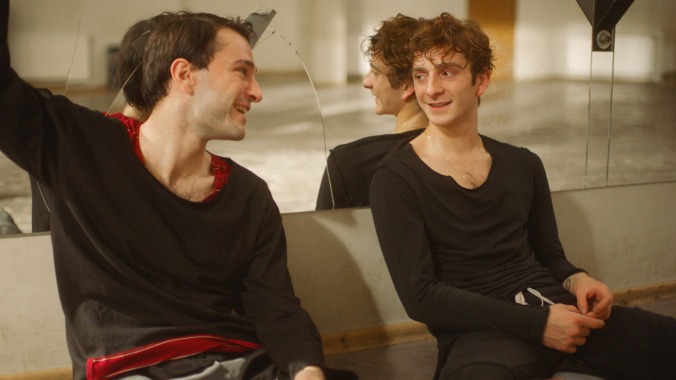Taboo romance gets a clumsy workout in And Then We Danced


“There is no sex in Georgian dance,” declares a gruff dance instructor named Aliko (Kakha Gogidze) at the beginning of Levan Akin’s And Then We Danced. The line’s obvious irony inspires titters from his students, who are uniformly young, hot, and fit; as we will soon learn, sex is just about the only thing they talk about when they get to the locker room. But the line could just as easily be interpreted as a self-reflexive wink to the audience. Because just as there is no sex in traditional Georgian dance, there are also apparently no gay men—which explains why Akin’s innocuous drama about the sexual awakening of a male dancer had to be produced with a degree of secrecy. (The film’s choreographer, for instance, has remained anonymous.)
Akin, a Swedish writer-director who comes from a family of ethnic Georgians from Turkey, is not exactly an insider in this milieu. But he’s stumbled on something in setting a gay love story at an elite traditional dance school in Georgia. At heart, Georgian dance is a dance of gender roles in which the male dancers’ displays of athletically stylized machismo get most of the attention. Dressed in chokhas—the traditional long coats of the Caucasus, decorated with pockets for rifle cartridges across the chest—the men perform impossible struts, leaps, spins, and landings. Sometimes they carry swords or wear the imposing woolen hats called papakhas, acting out ideals of camaraderie, competition, and manly pursuits in dance.
We never see any examples of this national art form’s awe-inspiring stage shows in And Then We Danced. The dancing is mostly depicted in practice and rehearsal in a featureless room, captured in raggedly cut handheld sequences that betray the movie’s modest means. If Akin knows how to direct better than this, he rarely shows it. But if he never displays a knack for visualizing the physicality of dance (more impressive rehearsal footage can be found in about five seconds on YouTube), he does a decent job of conveying the frustration and passion it inspires in Merab (Levan Gelbakhiani, a professional dancer).
Fresh-faced and bendy, Merab has spent his entire life working hard to become a traditional Georgian dancer—just like his father, a disillusioned former star who once toured the world with a dance troupe, but now sells car parts from a stall at a flea market. Perhaps we are meant to read Merab’s impossible ambitions as a parallel to his attraction to Irakli (Bachi Valishvili), who makes his entrance in Aliko’s class in the opening scene, drawing increasingly conspicuous glances. The handsome new arrival (whose first name is “Hercules” in Georgian) is a raw talent, which makes him something like Merab’s opposite.
They become practice partners, then close friends, and then a whole lot more. Working in unwaveringly broad strokes of characterization and cultural background, Akin still finds time for those basic narrative dichotomies that are so literally embodied in most movies about dancers—the liberating power of dance versus tradition, ambition versus the limits of physical strain. The dance academy is both competitive and homophobic, its environmental pressures neatly summed up by the fact that Merab is auditioning for a slot in the main dance company that has been vacated after one of the troupe’s stars was outed during a recent tour in Armenia. Not that the movie is all that interested in dark ironies or anguish. Its tone is woozy, following characters off to trips to the countryside and to dance clubs.
Though Akin has stated that And Then We Danced was inspired by encounters with activists in Georgia, it’s hard to imagine the film existing without the idyllic influence of Luca Guadagnino’s Call Me By Your Name. But Akin lacks the discipline and the creativity of Guadagnino’s direction—that combination of maximalist tendencies and rigorously self-imposed rules. Instead, he directs almost every scene in the same prettified, handheld, wide-open-aperture style, with shallow depth of field and incessantly jumpy editing that ensures that there’s only one thing to see in each shot. The casualties of this approach include many of the dance sequences in the film—even the one that finds Merab performing an impromptu interpretation of Robyn’s “Honey” shirtless on a veranda, wearing his papakha like a camp wig.
And Then We Danced only breaks with this style in its emotional climax. Set at a wedding party, it’s directed in two long, complicated Steadicam shots that follow and reframe Merab through doorways and differently lit spaces to a conversation with Irakli in a quiet room and then out to a courtyard that is framed in a high angle through the window. It’s the only time that the film matches its protagonist’s romantic ambition. The unintended side effect is that it makes the rest look even flimsier.